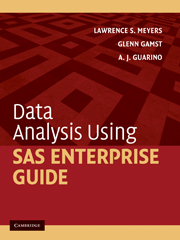Book contents
- Frontmatter
- Contents
- Preface
- Acknowledgments
- I Introducing SAS Enterprise Guide
- II Performing Analyses and Viewing Output
- III Manipulating Data
- IV Describing Data
- V Score Distribution Assumptions
- VI Correlation and Prediction
- VII Comparing Means: The t Test
- VIII Comparing Means: ANOVA
- IX Nonparametric Procedures
- 27 One-Way Chi-Square
- 28 Two-Way Chi-Square
- 29 Nonparametric Between-Subjects One-Way ANOVA
- X Advanced ANOVA Techniques
- XI Analysis of Structure
- References
- Author Index
- Subject Index
29 - Nonparametric Between-Subjects One-Way ANOVA
Published online by Cambridge University Press: 05 June 2012
- Frontmatter
- Contents
- Preface
- Acknowledgments
- I Introducing SAS Enterprise Guide
- II Performing Analyses and Viewing Output
- III Manipulating Data
- IV Describing Data
- V Score Distribution Assumptions
- VI Correlation and Prediction
- VII Comparing Means: The t Test
- VIII Comparing Means: ANOVA
- IX Nonparametric Procedures
- 27 One-Way Chi-Square
- 28 Two-Way Chi-Square
- 29 Nonparametric Between-Subjects One-Way ANOVA
- X Advanced ANOVA Techniques
- XI Analysis of Structure
- References
- Author Index
- Subject Index
Summary
Overview
We covered one-way between-subjects ANOVA in Chapter 23. Among other assumptions of ANOVA are that the scale of measurement underlying the dependent variable is at least an approximation to interval (i.e., it is meaningful to compute means and standard deviations) and that the dependent variable distributions within the groups are relatively normal. If the distributions departed substantially from the normality assumption and if the researchers did not choose to subject their data to a nonlinear transformation, or if the researchers collected ranked data, then they can opt to use a distribution-free nonparametric analogue to the one-way between-subjects ANOVA.
The nonparametric analogues to One-Way ANOVA
We briefly treat two of the most commonly used nonparametric analogues to a one-way between-subjects ANOVA: the median test and the Kruskal–Wallis test. In both cases, there are two or more independent groups of cases that have been assessed on a dependent variable that reaches at least ordinal measurement.
The median test
The median test is a relatively imprecise test, in the sense that a good deal of the information in the data is discarded in the computation. Its advantage is that it is relatively simple to compute, a modest advantage indeed in computer-based data analysis. For the purposes of the analysis, the data for all groups are momentarily combined so that a median of the entire set of scores is computed. It is then simply determined how many scores in each group are above and below that common median.
- Type
- Chapter
- Information
- Data Analysis Using SAS Enterprise Guide , pp. 291 - 296Publisher: Cambridge University PressPrint publication year: 2009



